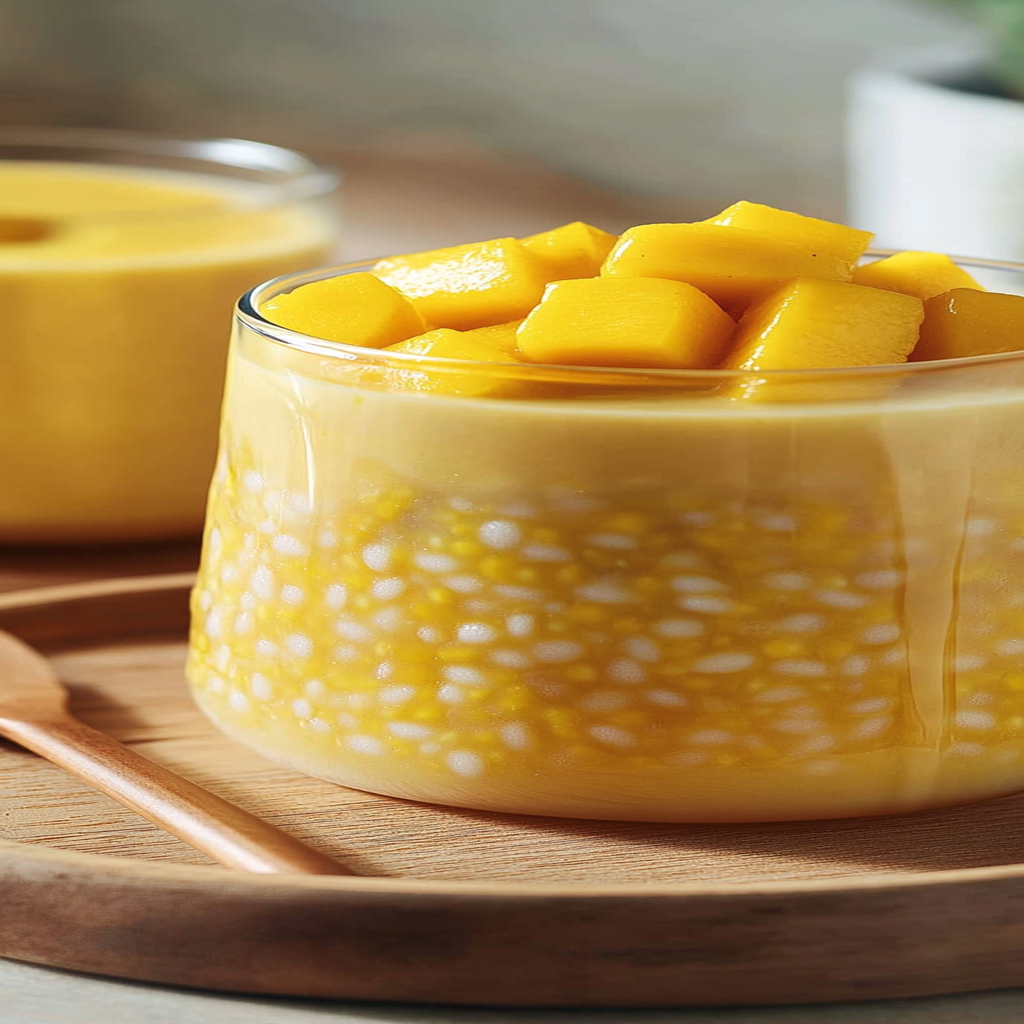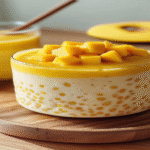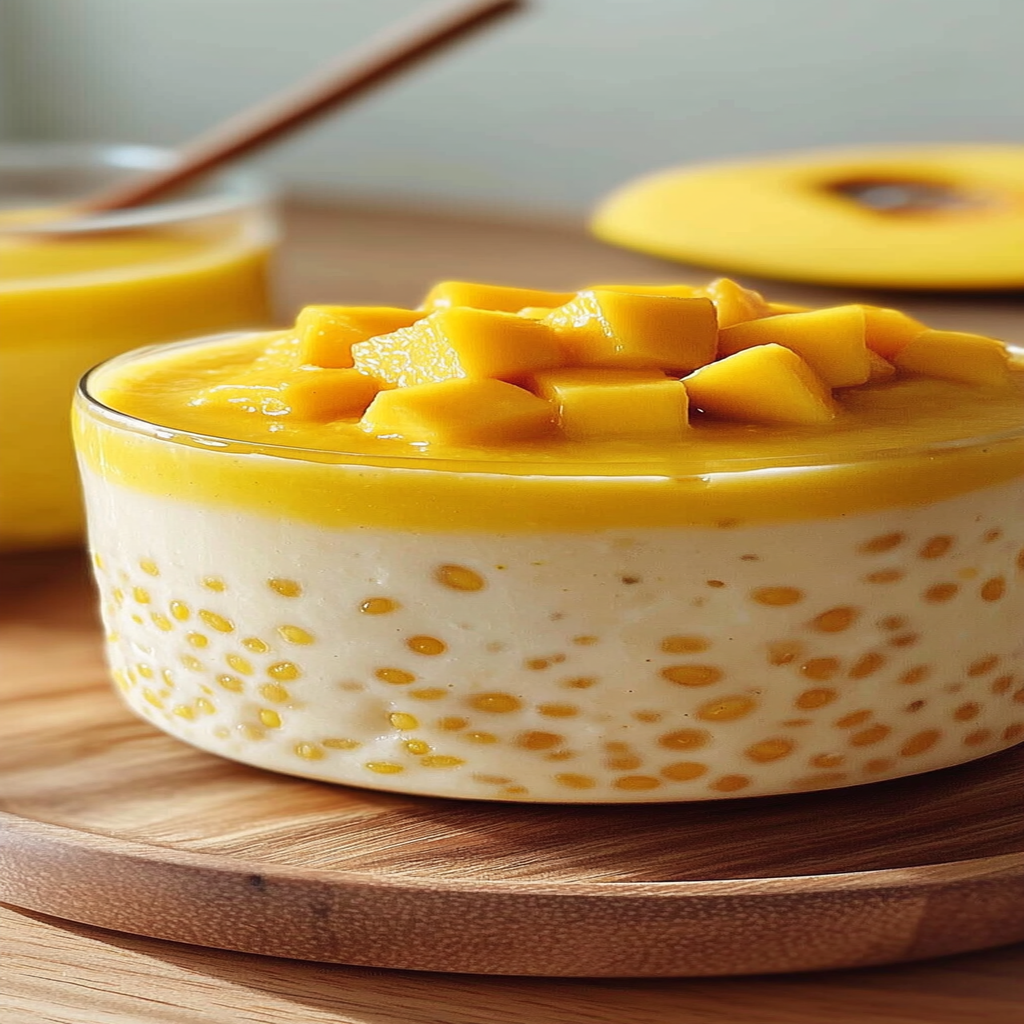Mango Sago is like a tropical vacation in a bowl. Imagine the sweet, juicy mangoes mingling with creamy coconut milk, creating a symphony of flavors that dance on your taste buds. Each spoonful is a delightful mix of textures—smooth, creamy, and just the right amount of chewy from the sago pearls. It’s an explosion of sunshine that can brighten even the gloomiest day.
Now, let me take you back to that summer barbecue when I first tasted this heavenly dessert. There I was, surrounded by friends, laughter echoing through the air as we devoured plate after plate of grilled goodness. Then came the Mango Sago, served in these cute little cups that looked like they belonged on a magazine cover. I took one bite, and oh boy! It was pure bliss! From that day forward, I knew this dish was destined to be a regular at my gatherings.
Why You'll Love This Recipe
- Mango Sago is incredibly easy to whip up and requires minimal ingredients.
- The flavor profile blends tropical sweetness with a hint of creaminess that’s simply irresistible.
- Its vibrant colors and presentation make it a showstopper at any occasion.
- Perfect for parties or simply treating yourself after a long day!
Ingredients for Mango Sago
Here’s what you’ll need to make this delicious dish:
- Ripe Mangoes: Use juicy, sweet mangoes for the best flavor; look for ones with slight give when pressed.
- Sago Pearls: These tiny tapioca pearls create the unique texture; make sure to soak them before cooking.
- Coconut Milk: Full-fat coconut milk adds creaminess; opt for unsweetened for better control over sweetness.
- Sugar: Adjust according to your taste; granulated sugar works perfectly for sweetness.
- Water: You’ll need this for cooking the sago; use clean filtered water for best results.
The full ingredients list, including measurements, is provided in the recipe card directly below.

How to Make Mango Sago
Follow these simple steps to prepare this delicious dish:
Step 1: Prepare the Sago Pearls
Start by soaking about half a cup of sago pearls in water for approximately an hour. This allows them to absorb moisture and soften up nicely.
Step 2: Cook the Sago
Bring a pot of water to boil over medium heat. Add the soaked sago pearls and cook them until they turn translucent—this usually takes around 15 minutes. Remember to stir occasionally so they don’t stick together!
Step 3: Drain and Rinse
Once cooked, drain the sago in a fine sieve and rinse under cold water to stop further cooking and remove excess starch.
Step 4: Blend the Mangoes
While your sago is cooling off, peel and chop two ripe mangoes into chunks. Toss these into a blender along with half a cup of coconut milk and sugar to taste. Blend until smooth but leave some small mango bits for texture!
Step 5: Combine Everything
In a large bowl, mix your cooked sago pearls with the blended mango mixture. Stir well until everything is combined evenly.
Step 6: Chill and Serve
Transfer your creamy Mango Sago into serving bowls or cups and chill in the refrigerator for at least an hour before serving. Garnish with fresh mango slices or mint leaves if you’re feeling fancy.
Now you’re ready to dig in! Transfer to plates or bowls if you want extra points for presentation and enjoy every mouthful of this tropical delight.
You Must Know
- This delightful Mango Sago offers a burst of tropical flavor that’s not only refreshing but easy to whip up.
- You can adjust sweetness and creaminess to suit your taste.
- Perfect as a dessert, it’s also a fantastic snack on warm days.
Perfecting the Cooking Process
Start by soaking the sago pearls until they become transparent. Then, cook them in boiling water while preparing the mango puree. Finally, combine everything with coconut milk for a harmonious blend of flavors.
Add Your Touch
Feel free to experiment with different fruits like strawberries or kiwi for a colorful twist. You can also adjust the coconut milk and sugar levels to find your perfect balance of creaminess and sweetness.
Storing & Reheating
Store leftover Mango Sago in an airtight container in the fridge for up to three days. To serve, simply give it a good stir; there’s no need to reheat this chilled treat!
Chef's Helpful Tips
- Use fresh mangoes for the best flavor; overripe ones can be too mushy and sweet.
- Rinse sago thoroughly before cooking to remove excess starch for better texture.
- Always let the sago cool completely before combining with other ingredients for a perfect finish.
Sometimes, I whip up Mango Sago during family gatherings, and watching everyone devour it brings me so much joy—it’s my secret weapon for winning hearts!
FAQs :
What is Mango Sago?
Mango Sago is a delightful dessert that originates from Southeast Asia, particularly popular in countries like the Philippines and Malaysia. It combines fresh mango puree with sago pearls, which are small tapioca balls. The dish is often served with coconut milk or cream for added richness. This refreshing treat has become widely loved for its sweet and creamy flavor, making it an ideal dessert for warm weather or special occasions.
How do you make Mango Sago?
To make Mango Sago, start by cooking the sago pearls until they become translucent and chewy. Rinse them under cold water to remove excess starch. Next, blend ripe mangoes to create a smooth puree. In a bowl, combine the cooked sago with mango puree and add coconut milk for creaminess. Chill the mixture in the refrigerator before serving. Garnish with diced mangoes or mint leaves for presentation.
Can I substitute ingredients in Mango Sago?
Yes, you can substitute some ingredients in Mango Sago based on your preferences or dietary restrictions. Instead of using coconut milk, you can opt for almond milk or any other non-dairy milk if you want a lighter version. For those who prefer a different fruit flavor, consider using passion fruit or avocado in place of mango. However, the classic taste of Mango Sago shines best when made with fresh mangoes.
How long can I store Mango Sago?
Mango Sago can be stored in an airtight container in the refrigerator for up to three days. However, keep in mind that the texture of sago pearls may change slightly over time as they absorb moisture from the coconut milk. It’s best to enjoy this dessert fresh for optimal taste and texture. If you’re preparing it ahead of time, consider waiting to mix in the coconut milk until just before serving.
Conclusion for Mango Sago :
Mango Sago is a deliciously refreshing dessert that combines sweet mangoes and chewy sago pearls for a delightful treat. With its simple preparation method, it’s perfect for home cooks looking to impress guests or cool off on warm days. Whether enjoyed at parties or family gatherings, this dessert brings joy with every bite. Remember to use fresh ingredients for the best results and feel free to customize it according to your taste preferences! Enjoy your homemade Mango Sago!

Mango Sago
- Prep Time: 15 minutes
- Cook Time: 15 minutes
- Total Time: 30 minutes
- Yield: Serves 4
- Category: Dessert
- Method: Chilling
- Cuisine: Southeast Asian
Description
Experience a burst of tropical flavor with this refreshing Mango Sago dessert, featuring creamy coconut milk, chewy sago pearls, and luscious mango puree. Perfect for warm days!
Ingredients
- 2 ripe mangoes
- 1/2 cup sago pearls
- 1 cup full-fat coconut milk (unsweetened)
- 1/4 cup granulated sugar
- 3 cups clean filtered water
Instructions
- Soak sago pearls in water for about 1 hour.
- Bring 3 cups of water to a boil.
- Add soaked sago pearls and cook until translucent, about 15 minutes. Stir occasionally to prevent sticking.
- Drain cooked sago in a fine sieve and rinse under cold water to stop cooking and remove excess starch.
- Peel and chop mangoes into chunks.
- Blend mango chunks with coconut milk and sugar until smooth, leaving some small bits for texture.
- In a large bowl, mix cooked sago pearls with blended mango mixture until well combined.
- Transfer the mixture into serving bowls or cups.
- Chill in the refrigerator for at least 1 hour before serving. Garnish with fresh mango slices or mint leaves if desired.
Nutrition
- Serving Size: 1 cup (250g)
- Calories: 290
- Sugar: 25g
- Sodium: 30mg
- Fat: 11g
- Saturated Fat: 10g
- Unsaturated Fat: 1g
- Trans Fat: 0g
- Carbohydrates: 43g
- Fiber: 2g
- Protein: 3g
- Cholesterol: 0mg
Keywords: Use ripe, sweet mangoes for the best flavor. You can substitute coconut milk with almond milk for a lighter option. Feel free to experiment with other fruits like kiwi or strawberries for added variety.




Leave a Comment